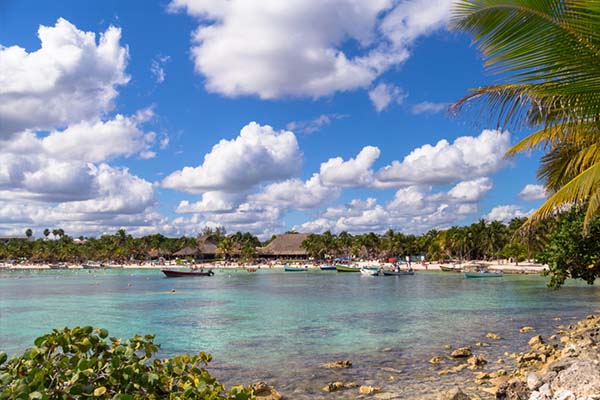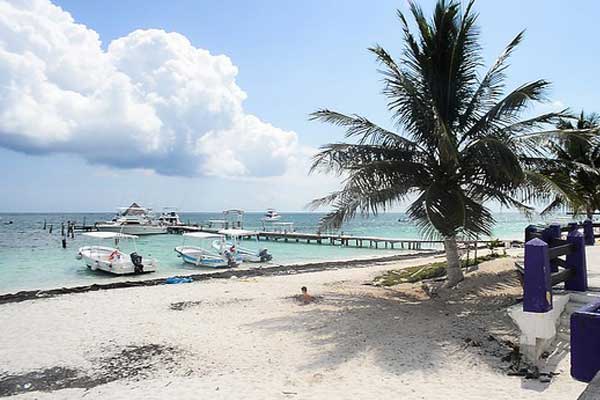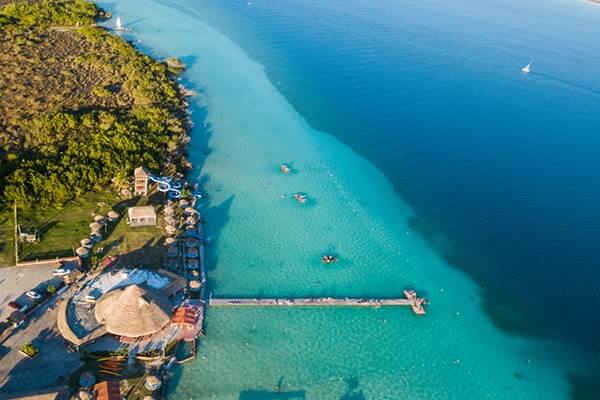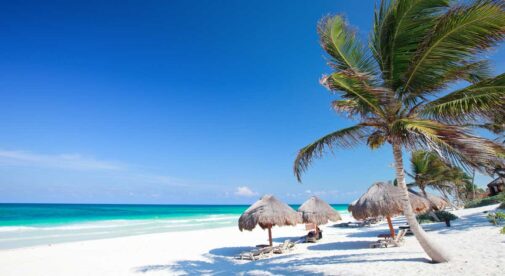The eastern coast of Mexico, along the shores of the Yucatan Peninsula, borders the warm, turquoise-green Caribbean Sea. There is a particularly well-known stretch that runs from Cancun down to Tulum and includes the popular destinations of Puerto Morelos, Playa del Carmen, Akumal, and Tulum. This well-known stretch is branded the Riviera Maya and its famous sugar sand beaches are the most popular vacation destination in the Caribbean basin.
[question_evergreen]
South of the Riviera Maya is a mostly undeveloped stretch of stunning, isolated beach called the Costa Maya. The Costa Maya is for those who enjoy the outdoor lifestyle…fishermen, divers, and those who love warm weather, palm trees, and silky sand.
Whether it’s the Riviera Maya or the Costa Maya, you’ll find postcard-worthy beaches here that can be enjoyed by retirees for a fraction of the price of living in the U.S. or Canada. If you’re looking for a place to sink your toes into the sand, swim in the ocean, and admire a stunning tropical sunset in peace, then Mexico’s Caribbean coast is perfect for you.
Read on to discover the best destinations to retire on Mexico’s Caribbean coast…
Akumal

Akumal is a small town, best known for the migrating sea turtles that visit every year to lay eggs along the shore. It’s a beach lover’s paradise, perfect for anyone who enjoys relaxing with their toes in the sand and an adult beverage in their hand. There is also a significant expat community.
This small village has five gorgeous white-sand beaches, liberally studded with majestic coconut palms and bathed by the warm, turquoise-green waters of the Caribbean Sea. Akumal’s temperature averages in the 80s F, with the hottest summer days climbing into the mid-90s F: perfect for a beachside or poolside cool-off with an ice-cold drink.
Until the last few years, Akumal, about an hour south of Playa del Carmen, was often a day trip for a small number of vacationers in Cancun and Playa del Carmen. These days, for better or worse, Akumal is no longer just a day trip but is emerging as a primary destination. In fact, sizeable real estate developments (one with its own championship golf course) have sprouted, encouraging investors and expat residents to make long-term commitments to the area.
Tulum

For decades, while most tourists stayed farther north in Cancún and Playa del Carmen, Tulúm was a backpackers’ haven. The atmosphere in Tulúm was low-key, the tourists young and casual, and the town filled with inexpensive, palapa-style hotels and restaurants.
How times have changed. Today Tulúm has gone upscale. Many of the bohemian types who gave Playa its vibe have moved south to Tulúm, opening restaurants, shops, and boutique hotels. Today you can still find stands selling tacos and beans…but you can also indulge in gourmet meals, yoga sessions, and spa treatments.
Expats have discovered Tulum and have been moving down, in increasing numbers, for the past decade. Thousands of snowbirds have also claimed Tulum as their winter nesting place as they escape the cold weather up north.
With a tropical climate—temperatures averaging in the 80s F—Tulúm offers a Caribbean lifestyle without the need to travel to and from an island. Residents enjoy warm, turquoise Caribbean waters, a sparkling, perfect beach, and an offshore reef which provides plentiful opportunities for fishing, scuba diving, and snorkeling.
Prices have risen accordingly (although there are still bargains to be found). Mexico’s government is positioning Tulúm as a high-end, exclusive destination…but the ambience is still inviting and low-key.
Playa del Carmen

Playa del Carmen lies about midway between the all-inclusive resort hub of Cancún and the up-and-coming, low-key, and still somewhat bohemian destination of Tulum. It’s a happy medium between those two extremes and a favorite for those seeking to live an active retirement in an atmosphere that is sophisticated yet laidback at the same time. Casual dress and relaxed attitudes are the keys to living in Playa del Carmen.
The heart of Playa del Carmen is the famous Quinta Avenida, or Fifth Avenue. It’s a miles-long pedestrian avenue lined with shops, boutiques, bars, cafés, and restaurants of every cuisine imaginable, from high-end to budget. It’s frequented by tourists in big numbers. But Quinta Avenida is also a favorite among expats for shopping and dining. Happy hours, group dinners, as well as parties at private homes, are the main social activities. The place has energy. Among those living in Playa del Carmen is a wide variety of nationalities. Americans and Canadians are the biggest groups, with significant numbers of Italians, French, and Argentinians.
Retiring in Playa del Carmen is attractive for many reasons. There is warm weather year-round, which makes it especially nice in winter. At that time, December to April, the city also plays host to snowbirds, winter residents who escape the cold part of the year by the beach.
Cancun

It’s impossible to talk about the Riviera Maya without mentioning Cancún. It’s the place that started it all. What was once a little sandy island became a focal point for tourism and exploded into a huge, world-class resort. It’s the region’s economic driver and has brought prosperity up and down the coast.
With dozens of sprawling, all-inclusive resorts standing watch over miles of sparkling sugar-sand beaches, swaying palms, and the warm, turquoise water of the Caribbean Sea, along with a vibrant nightlife, Cancun could easily define the ideal tropical retreat. With temperatures anchored in the mid-80s F for most of the year (some summer days breach 90 F), and plentiful sunshine, a casual lifestyle, and amazing food, what’s not to like?
Cancun is served by a modern, bustling international airport. Its location on the Yucatan Peninsula offers flights back to the States in less than two hours. And for those hesitating to make a move south of the border, Cancun eases you into the expat life as English is a common second language, thanks to the active tourist trade.
[mexico_signup]
Cozumel

Cozumel is a perfect blend of laidback island life with tons of activities to enjoy. Here you can have as relaxed or active a retirement as you want. You can park yourself on a perfect stretch of white-sand beach for the day, listening to the waves as you read the latest best-seller, or don a snorkel to explore the Chinchorro Reef, the world’s second-largest reef system, just offshore. Clear waters make it easy to see (and photograph) sea turtles, rays, and colorful clownfish. You can even make arrangements to swim with giant whale sharks.
Lying only 12 miles offshore from Playa del Carmen, about an hour south of Cancún, Cozumel is about 30 miles long and 10 miles wide. But this small space has a lot packed into it. With over 300 restaurants, delicious meals of all varieties are easy to find.
The bulk of Cozumel’s population calls the city of San Miguel home. There is a busy malecón (seaside boardwalk), or main road, running along the shoreline near the ferry terminal and cruise ship docks. Arriving by boat, you’ll find a vast array of tourist-oriented shops, restaurants, and bars. A few blocks inland will put you into local neighborhoods, where small houses and apartments line the streets and groups of uniformed children walk to and from school. Raise your eyes and you’ll note luxury condo buildings along the horizon, offering all the contemporary amenities.
Puerto Morelos

As you head south from Cancún, past the mega-resorts, including the massive Mayan Palace, the first town of any substantial size is Puerto Morelos. Just 18 miles south of Cancún, Puerto Morelos still retains some of its small-town, fishing-village charm. For those looking for an “in-between” spot that’s on the tourist map but not overrun, this might be a place to take a closer look. (Some people say Puerto Morelos is like Playa del Carmen in the early days.)
People of all nationalities meander along the small malecón taking photos. Restaurants are plentiful and the freshest seafood offerings are numerous. But there are usually a few food carts present, allowing you to sample some local street food. The old, leaning lighthouse provides the perfect backdrop for photos. And although it has clearly been discovered, Puerto Morelos remains the place you imagined it would be.
Dozens of small fishing boats bob at anchor, just offshore, as sea birds perch on the gunwales. The peaceful vibe almost demands that you awaken early to see the sunrise while walking barefoot on the beach, sipping champagne. The seafood is as good as it gets and the guacamole and margaritas are always perfect.

Isla Mujeres

Isla (as the locals call it) is tiny. About 4.5 miles long and half a mile wide, it’s much smaller than Cozumel. Some 13,000 residents now call this tiny Caribbean gem their home.
Lying about eight miles off Cancún, Isla provides the sense of independence cherished by island dwellers. But it’s also conveniently close to the mainland and big-city comforts. And although Isla has been discovered by international tourists, and Cancún locals regularly pack lunches and beach gear for day trips to this idyllic retreat, it still retains much of the charm and “get-away-from-it-all” vibe people come to islands to enjoy.
Even the tourist shops, restaurants, and bars lining both sides of the main street for a couple of blocks seem laidback and friendly. The smells of crispy fried fish, fresh-cut limes, hot tortillas, and French fries drift from doorways, pulling hungry patrons off the street as if for a taste. Scooters may be everywhere on Cozumel, but here golf carts are the vehicle of choice. From the streets, golf cart rentals beckon with cardboard signs proclaiming daily rental rates.
In terms of lifestyle, Isla has all the same tropical-island options as Cozumel. Diving, snorkeling, boating, and fishing are all possibilities, and paddleboarding is also popular. Chedraui, a major brand supermarket, has an outlet on the island. There’s also a Navy hospital and a couple of medical clinics. Major medical needs are mostly handled in Cancún.
Mahahual

The little town of Mahahual (also spelled “Majahual”) is the heart of the Costa Maya. Flattened by Hurricane Dean in 2007, Mahahual has taken the opportunity to rebuild itself better than it was before: with some city planning and an eye to hurricane-resistant construction. There is a cruise ship dock here, an improved beachfront area, and a malecón that runs pretty much the length of town.
Mahahual’s malecón is lined with restaurants, bars, and souvenir shops. (Many of the restaurants set up tables on the sand between the malecón and the beach, where patrons have an unobstructed view of the waves and water.)
Increasingly, you’ll also find condos and houses freshly constructed along the malecón, and signs of new construction abound. In fact, these days, along the entire length of Mahahual, the first two to three blocks back from the malecón are filled with new buildings and construction.
It sits upon a shoe-shaped peninsula bordered on the east by the Caribbean Sea and creating Chetumal Bay, just above the toe. Driving north and south on the peninsula, along the beach will acquaint you with five or six small villages, the southernmost being Xcalak on the water border with Belize.
[mexico_signup]
Xcalak

Xcalak is a small fishing village on the southern tip of the Yucatan Peninsula, in the State of Quintana Roo. The town is remote, and so far, south, it’s only six miles to the Belize/Mexico border. At a whopping six-hour drive from Cancun, not many tourists make it to Xcalak, and that’s too bad for them. But maybe it’s good for you.
In Xcalak, though, you won’t find any mega-resorts, high-end shopping, or fast food chains. It’s a quiet village of 400 residents with miles of undeveloped beaches backed by a thick jungle. Stretching along Xcalak’s coast is the second-largest barrier reef in the world, part of which is designated as the Xcalak Reef National Marine Park. The protected waters along the reef abound with underwater life, making Xcalak both a world-class fly-fishing destination and a snorkeler’s paradise.
Given Xcalak’s limited development, you’d be right to guess that the tourist hotels take sustainability seriously. Accommodations are off-grid, which gives any vacation in Xcalak a touch of adventure.
Holbox

For peace and tranquility seemingly far from civilization, head to Isla Holbox (pronounced Oal-Bosh). This sliver of an island rests off the Yucatán Peninsula’s northeast coast, where the Gulf of Mexico and the Caribbean Sea meet.
Holbox truly feels like the old-time Caribbean. No cars are permitted on the island; golf carts are the main form of transport. streets are made from packed sand and, until recently, there was no cell phone or internet service.
Holbox was a quiet fishing island until swimming with whale sharks took off. Tourists came to the island, bringing much-needed revenue with them. There are now a few hotels, bars, and restaurants, as well as amazing beaches strewn with shells.
Getting here involves a 30-minute ferry ride from the small terminal of Chiquilá, a 1.5-hour drive from Cancún.
Bacalar

If the crowds associated with a huge resort area are not your cup of tea, the small village of Bacalar, two-plus hours south of Tulum, may be the quiet, lakefront retreat you’ve been looking for.
Sitting on the shore of Laguna Bacalar (Lake Bacalar), the village exudes an authentic charm with its small, town square surrounded by family-owned businesses. Spend a little time there and you might find yourself imagining you’re in the Mexican version of Mayberry from the old television series.
Technically speaking, Lake Bacalar is not on Mexico’s Caribbean Coast. It lies about an hour inland. But it looks like the Caribbean, feels like the Caribbean…and has a few special advantages that are all its own. If you like the look of the Caribbean but could do without the saltwater, Lake Bacalar may be the perfect spot for you.
Laguna Bacalar is the crown jewel in a system of freshwater lakes and waterways in southern Quintana Roo that eventually lead to the Caribbean. The lake is about 35 miles long, running north and south parallel to the Caribbean Coast. It’s Mexico’s second-largest freshwater lake—after Lake Chapala—and it’s famous for the water’s range of colors. (In fact, it’s known as the Lake of Seven Colors.) Fed by cenotes (deep sinkholes in the limestone shelf that lead to underground rivers) the lake’s waters are cool, extremely clear and vary spectacularly in color, from a translucent turquoise to deep navy blue.
Chetumal

Chetumal may be the least-known city along Mexico’s Caribbean coast (to tourists and prospective expats) but is probably the most important. Chetumal, on the southeast tip of the Yucatan Peninsula, is the Capital of the Yucatan state of Quintana Roo.
Chetumal is clean and feels rather like a Southern California beach town. It offers a wide variety of conveniences, including medical facilities, a university, shopping malls, movie theaters, department stores, supermarkets, and hardware stores. Chetumal is close to the free-trade zone on the Belize border, where you can buy low-priced goods from around the world.
Across the bay from Mahahual, Chetumal is an unmistakably Mexican town, unlike some of the more touristy areas on the Riviera Maya. And while Chetumal has a steadily growing expat community, anyone who moves there should be prepared to speak Spanish.
[mexico_signup]
Related Articles
My Typical Day In The Mexican Caribbean
5 Best Caribbean Islands to Live On… and 2 to Avoid
Guide to The Caribbean Islands
[post_takeover]
[lytics_best_articles_collection]

